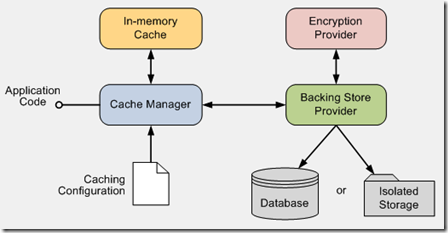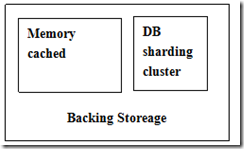浅谈缓存的设计与使用注意项(上)
2010-12-28 00:13 姜 萌@cnblogs 阅读(1772) 评论(0) 编辑 收藏 举报memory cache + backing store
enterprise libiary中的caching block
在微软pattern&practise团队发布的enterprise library5版本中带有一个caching block,这个缓存块为我们提供了缓存数据大一些列方法。其架构如下图(这里再说明一下:caching block以后会被整合进.net framework之中,enterlib5的后续版本会将caching block剔除):
caching block采用的是“内存缓存+backing store”结构(不过backing store是可选的),程序启动时缓存被加载到memory cache,也就是进程内存中(具体有两种加载策略,positive和reactive),当我们通过key调用对应的缓存项时首先在内存中查找,如果没有就去backing store查找,对于已经夹在到内存中的缓存项只有在其过期或者手动remove才会剔除而不会因为backing store的变化被主动通知到,这个特点会影响到多进程实例/同一进程不同程序域对backing store访问问题,这部分将在下篇提到。
扩展backing storeage
backing store有三种形式:
| Isolated storage | 缓存到隔离存储中 |
| Database cache storage | 缓存到数据库中 |
| Custom backing storage | 自行实现IBackingStore |
对于一般情形,我们在客户端使用IsolatedStorage作为backing store在服务器端使用Database cache storage作为backing store比较合适,如果您需要更高的效能,可以自定义实现IBackingStore,比如将MemoryCached与缓存数据库相结合作为IBackingStore。
只需要实现IBackingStorage如下:
{
[Dependency]
public IBackingStore DbObjectProvider
{
get;
set;
}
[Dependency]
public IBackingStore MemoryCachedProvider
{
get;
set;
}
public void Add(CacheItem newCacheItem)
{
if (MemoryCachedProvider.IsAvailable)
{
MemoryCachedProvider.Add(newCacheItem);
}
else if (DbObjectProvider.IsAvailable)
{
DbObjectProvider.Add(newCacheItem);
}
else
throw new BackCachingSourceException();
}
public int Count
{
get
{
return MemoryCachedProvider.Count + DbObjectProvider.Count;
}
}
public void Flush()
{
MemoryCachedProvider.Flush();
DbObjectProvider.Flush();
}
public System.Collections.Hashtable Load()
{;
return MemoryCachedProvider.Load();
}
public void Remove(string key)
{
if (MemoryCachedProvider.Remove(key))
return;
if (DbObjectProvider.Remove(key))
return;
}
public void UpdateLastAccessedTime(string key, DateTime timestamp)
{
MemoryCachedProvider.UpdateLastAccessedTime(key, timestamp);
DbObjectProvider.UpdateLastAccessedTime(key, timestamp);
}
public void Dispose()
{
MemoryCachedProvider.Dispose();
DbObjectProvider.Dispose();
}
}






